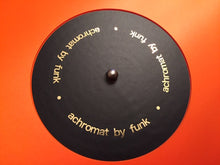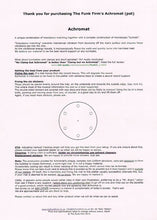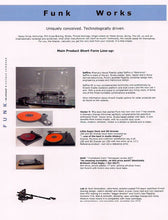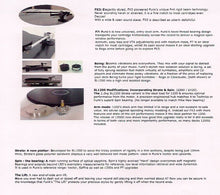
Imagine turntable perfection - a symbiosis resulting from a perfect closed loop. Do something daft; use a wrong mat and break the loop and reproduction is ruined! Obvious?
In 1980, the undisputed choice to sit a record on was a soft felt mat. It must have been right. Or was it rubber, or silicone, or cork, or ? All claimed to be best at "damping," but how could they all be right? The answer? No one had a clue! A classic example of "Random Evolution" at work?
Then Arthur Khoubesserian arrived. Forwarding a theory matching disc/platter impedance, he released the Pink Triangle with its naked acrylic platter. This caused nothing short of uproar in the industry. His (now logical) suggestion to sit a record directly on "hard" acrylic was heresy. Heresy? The idea worked! Seems like someone actually knew what they were up to. Today, survival of the fittest means acrylic platters are "de rigueur" in all self-respecting quality turntables. What is it that they say about imitation and flattery?
Unfortunately for the competition today, for all its benefits, acrylic's limitations have caught up. Its mechanic-acoustic impedance doesn't precisely match that of the record. In thin sections its characteristic are poor, so as a mat it is not very good.
Now, The Funk Firm introduces the next stage in vinyl evolution: Achromat Record Mat. Achromat's new material matches records 100 percent. It can't get better. It doesn't stop there. Achromat is further optimized by the introduction of bubbles. These gradually increase internal damping making Achromat more effective. The reduced weight helps for use as a universal mat.
The results you'll hear are more space and air, inky black backgrounds, layered timbral color, better midband resolution and sonorous deep bass.
These record mats are designed to be coupled to the platter using the provided stickers. They may not be perfectly flat, that is the purpose of the stickers.
"Stylus motion releases mechanical (vibrational) energy. For a mat to do its job, this energy must first enter it, uniformly. If the mat has the same characteristics as the record, the energy easily enters. But that's not enough! "
"In Achromat it then travels thourgh very long microscopic tunnels, dissipating energy gradually and harmlessly as molecular heat, never returning. We hear this as a major improvement in sound quality. If the material is of a different nature to the record, the amount of energy entering the mat has a varying quality - why different mats sound, well "different". The Achromat and Achroplat are of identical characteristics to the record."
"Does it work? Yes, remarkably so. Even on a relatively humble setup, I noticed a significant improvement when swapping cork or felt for the Achromat. The bass is tighter, the mids and highs have greater separation, and overall, the result is more natural and spacious sounding. I could spend evening-after-evening rediscovering my record collection, each time enjoying the impressive level of new depth and detail." - Marc Henshall, Sound Matters Read more!
SPECIAL NOTE: The 5mm is the standard recommended thickness. In tests it consistently comes top over the 3mm mat. Not by a lot but it is noticeable. So wherever possible go for the 5mm. Why the 3mm, then? Rega arms for example have no VTA capability or are very awkward to adjust. They are also commonly found on decks with felt mats about 3mm thick. A special version of Achromat has been made available as a convenient way to get most of the benefits that Achromat has to offer. Another reason is for those decks with short spindles and a clamp; the 5mm would cause problems. It has to be noted, however, that when "tnt" reviewed the mat under such circumstances, they concluded that the benefits of the thicker mat outweighed the benefits of the thinner mat with the clamp! Nevertheless, the choice is left for you to make.
Dimensions:
11 5/8 inch Diameter
5 mm thickness
In 1980, the undisputed choice to sit a record on was a soft felt mat. It must have been right. Or was it rubber, or silicone, or cork, or ? All claimed to be best at "damping," but how could they all be right? The answer? No one had a clue! A classic example of "Random Evolution" at work?
Then Arthur Khoubesserian arrived. Forwarding a theory matching disc/platter impedance, he released the Pink Triangle with its naked acrylic platter. This caused nothing short of uproar in the industry. His (now logical) suggestion to sit a record directly on "hard" acrylic was heresy. Heresy? The idea worked! Seems like someone actually knew what they were up to. Today, survival of the fittest means acrylic platters are "de rigueur" in all self-respecting quality turntables. What is it that they say about imitation and flattery?
Unfortunately for the competition today, for all its benefits, acrylic's limitations have caught up. Its mechanic-acoustic impedance doesn't precisely match that of the record. In thin sections its characteristic are poor, so as a mat it is not very good.
Now, The Funk Firm introduces the next stage in vinyl evolution: Achromat Record Mat. Achromat's new material matches records 100 percent. It can't get better. It doesn't stop there. Achromat is further optimized by the introduction of bubbles. These gradually increase internal damping making Achromat more effective. The reduced weight helps for use as a universal mat.
The results you'll hear are more space and air, inky black backgrounds, layered timbral color, better midband resolution and sonorous deep bass.
These record mats are designed to be coupled to the platter using the provided stickers. They may not be perfectly flat, that is the purpose of the stickers.
"Stylus motion releases mechanical (vibrational) energy. For a mat to do its job, this energy must first enter it, uniformly. If the mat has the same characteristics as the record, the energy easily enters. But that's not enough! "
"In Achromat it then travels thourgh very long microscopic tunnels, dissipating energy gradually and harmlessly as molecular heat, never returning. We hear this as a major improvement in sound quality. If the material is of a different nature to the record, the amount of energy entering the mat has a varying quality - why different mats sound, well "different". The Achromat and Achroplat are of identical characteristics to the record."
"Does it work? Yes, remarkably so. Even on a relatively humble setup, I noticed a significant improvement when swapping cork or felt for the Achromat. The bass is tighter, the mids and highs have greater separation, and overall, the result is more natural and spacious sounding. I could spend evening-after-evening rediscovering my record collection, each time enjoying the impressive level of new depth and detail." - Marc Henshall, Sound Matters Read more!
SPECIAL NOTE: The 5mm is the standard recommended thickness. In tests it consistently comes top over the 3mm mat. Not by a lot but it is noticeable. So wherever possible go for the 5mm. Why the 3mm, then? Rega arms for example have no VTA capability or are very awkward to adjust. They are also commonly found on decks with felt mats about 3mm thick. A special version of Achromat has been made available as a convenient way to get most of the benefits that Achromat has to offer. Another reason is for those decks with short spindles and a clamp; the 5mm would cause problems. It has to be noted, however, that when "tnt" reviewed the mat under such circumstances, they concluded that the benefits of the thicker mat outweighed the benefits of the thinner mat with the clamp! Nevertheless, the choice is left for you to make.
Dimensions:
11 5/8 inch Diameter
5 mm thickness









